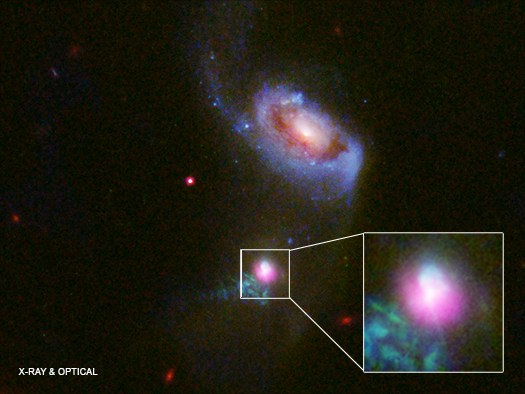For Release: Jan 11, 2018
NASA/CXC
The galaxy under study, called SDSS J1354+1327 (J1354 for short), is about 800 million light-years from Earth. The team used observations from NASA's Chandra X-ray Observatory and Hubble Space Telescope (HST), as well as the W.M. Keck Observatory in Mauna Kea, Hawaii, and the Apache Point Observatory (APO) near Sunspot, New Mexico.
Chandra detected a bright, point-like source of X-ray emission from J1354, a telltale sign of the presence of a supermassive black hole millions or billions of times more massive than our sun. The X-rays are produced by gas heated to millions of degrees by the enormous gravitational and magnetic forces near the black hole. Some of this gas will fall into the black hole, while a portion will be expelled in a powerful outflow of high-energy particles.
By comparing images from Chandra and HST, the team determined that the black hole is located in the center of the galaxy, the expected address for such an object. The X-ray data also show that the supermassive black hole is embedded in a heavy veil of gas.
The optical data indicate that, in the past, the supermassive black hole appears to have consumed, or accreted, large amounts of gas while blasting off an outflow of high-energy particles. The outflow eventually switched off then turned back on about 100,000 years later. This is strong evidence that accreting black holes can switch their power output off and on again over timescales that are short compared to the 13.8 billion-year age of the Universe.
"We are seeing this object feast, burp and nap, and then feast and burp once again, which theory had predicted," said Julie Comerford of the University of Colorado (CU) at Boulder's Department of Astrophysical and Space Science, who led the study. "Fortunately, we happened to observe this galaxy at a time when we could clearly see evidence for both events."
So why did the black hole have two separate meals? The answer lies in a companion galaxy that is linked to J1354 by streams of stars and gas produced by a collision between the two galaxies. The team concluded that clumps of material from the companion galaxy swirled toward the center of J1354 and then were eaten by the supermassive black hole.
The team used optical data from HST, Keck and APO to show that electrons had been stripped from atoms in a cone of gas extending some 30,000 light years south from the galaxy's center. This stripping was likely caused by a burst of radiation from the vicinity of the black hole, indicating that a feasting event had occurred. To the north they found evidence for a shock wave, similar to a sonic boom, located about 3,000 light years from the black hole. This suggests that a burp occurred after a different clump of gas had been consumed roughly 100,000 years later.
"This galaxy really caught us off guard," said CU Boulder doctoral student Rebecca Nevin, a study co-author who used data from APO to look at the velocities and intensities of light from the gas and stars in J1354. "We were able to show that the gas from the northern part of the galaxy was consistent with an advancing edge of a shock wave, and the gas from the south was consistent with an older outflow from the black hole."
Our Milky Way galaxy's supermassive black hole likely had at least one burp within the last few million years ago. In 2010 another research team discovered evidence for a Milky Way belch using observations from the orbiting Fermi Gamma-ray Observatory to look at the galaxy edge on. Astronomers saw gas outflows dubbed "Fermi bubbles" that shine in the gamma-ray, X-ray and radio wave portions of the electromagnetic spectrum. The burp would have a different cause than J1354's, since the Milky Way is not interacting with a nearby galaxy.
"These are the kinds of bubbles we see after a black hole feeding event," said CU postdoctoral fellow Scott Barrows. "Our galaxy's supermassive black hole is now napping after a big meal, just like J1354's black hole has in the past. So we also expect our massive black hole to feast again, just as J1354's has."
Other co-authors on the new study include postdoctoral fellow Francisco Muller-Sanchez of CU Boulder, Jenny Greene of Princeton University, David Pooley from Trinity University, Daniel Stern from the Jet Propulsion Laboratory in Pasadena, California, and Fiona Harrison from the California Institute of Technology.
A paper on the subject was published in a recent issue of The Astrophysical Journal and is available online. Julie Comerford presented the team's findings in a January 11th, 2018 press briefing at the 231st meeting of the American Astronomical Society held in Washington D.C. NASA's Marshall Space Flight Center in Huntsville, Alabama, manages the Chandra program for NASA's Science Mission Directorate in Washington. The Smithsonian Astrophysical Observatory in Cambridge, Massachusetts, controls Chandra's science and flight operations.
Media contacts:
Megan Watzke
Chandra X-ray Center, Cambridge, Mass.
617-496-7998
mwatzke@cfa.harvard.edu




Visitor Comments (2)
Wonderful work, helped to gain more knowledge.
Posted by Sudhin on Tuesday, 05.15.18 @ 13:10pm
Great work, wonderful. We will use this in our "Volkssternwarte" People observatory to teach young and adults about the great wonders in our universe. Thank You very much for your work. All the best and a Happy New Year to you.
Wolfgang
Volkssternwarte Paderborn, Germany
Posted by Wolfgang Dzieran on Sunday, 12.31.17 @ 06:22am